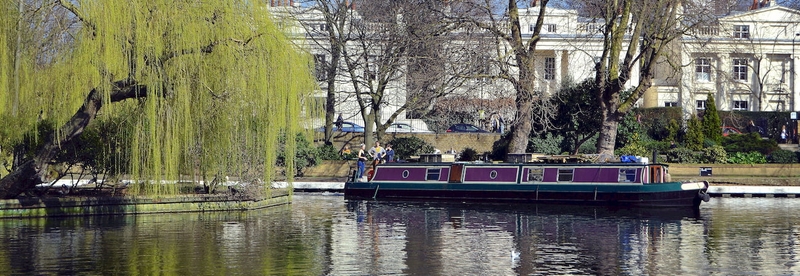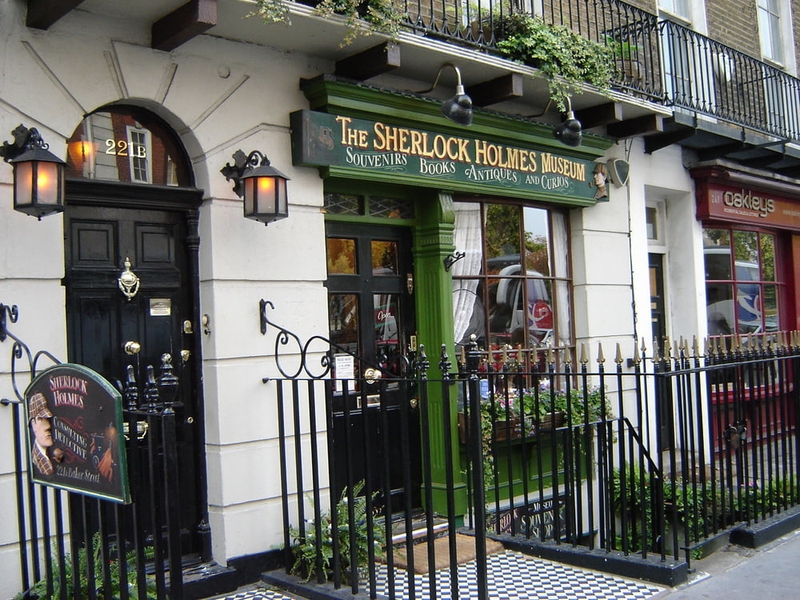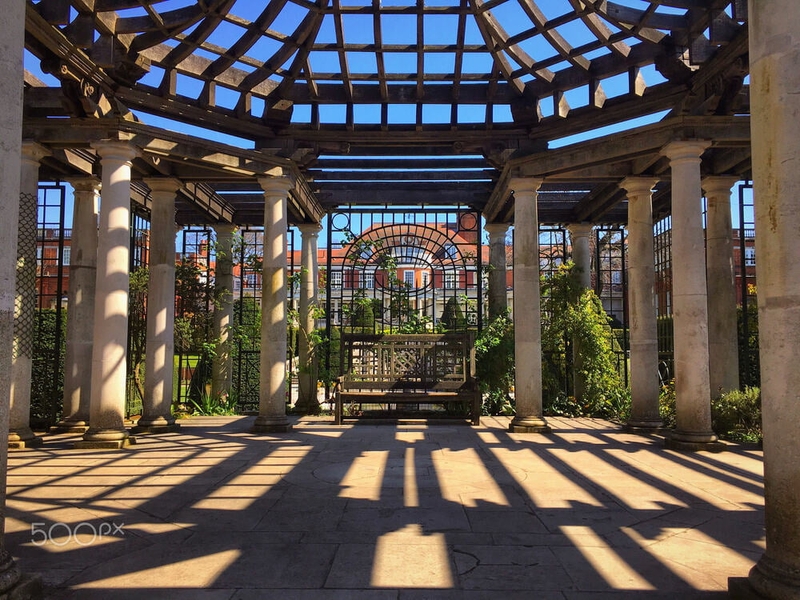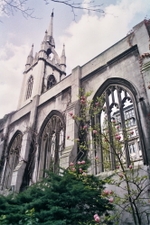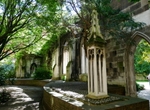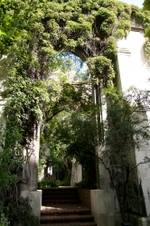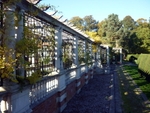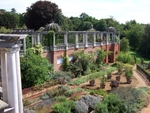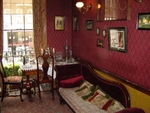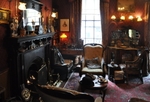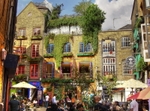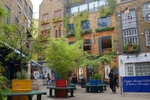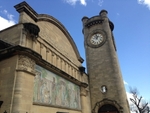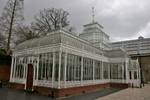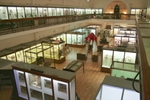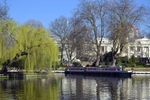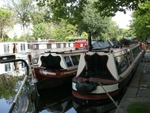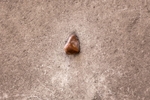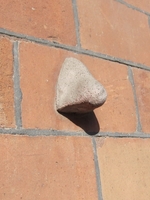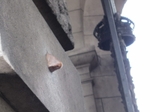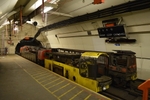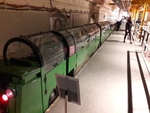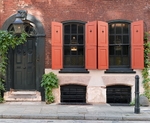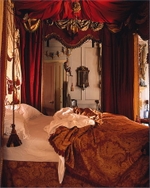1. Saint Dunstan in the East
The ruins of this medieval church in the city of London is certainly one of the capital’s hidden gems. The 12th century church building has a very chequered history, having been badly damaged in the Great Fire of 1666. It was rebuilt, but was once again severely damaged in the blitz during the second world war.
The bomb damage left just the Christopher Wren designed tower and steeple remaining, and this time the decision was taken not to rebuild the church. Instead, the church ruins form the background of a lovely and relaxing public garden, a little oasis in the heart of the capital. Lawns and trees were integrated in to the ruins, with the park opened to the public in 1971.
Saint Dunstan in the East offers locals and visitors a place to stroll or somewhere to enjoy a relaxing lunch amid the open-air ruins. The setting is also an appropriate spot for quiet reflection, with benches provided within the garden. Nature has quietly claimed the walls which in parts are draped in greenery, while a fountain adds to the atmosphere of calm tranquillity.
Saint Dunstan in the East is located just a few minutes from London Bridge, with Monument and Tower Hill the closest underground stations. The gardens are open from 8am and close at dusk, with entry free to all. Open-air services are still occasionally held in the grounds, Palm Sunday being one such occasion.
2. Hampstead Pergola and Hill Garden
Another hidden gem of a location can be found on Hampstead Heath. It is another example of a building brought back to life after allowing nature to take control.
The pergola was originally devised in the early 1900s as a place to hold garden parties, but the raised terrace has since become an atmospheric yet beautiful place for a walk.
The sense of faded grandeur adds to the atmosphere. Vines climb around the pergola and plants have taken shoot where they can, but instead of detracting from the space it has provided a unique spot away from the main areas of Hampstead Heath. From the raised terrace walkways you can enjoy the views down across the gardens.
Hampstead pergola sits overlooking the lovely landscaped Hill garden. The cultivated garden provides a wonderfully contrasting backdrop to the faded grandeur of the pergola, and once served as the private gardens of a manor which has since gone. The garden was opened to the public in 1963, with the pergola becoming part of the gardens in 1991.
The pergola and Hill garden sits toward the western fringes of Hampstead Heath, just off North End Way. The site slopes down from nearby Inverforth House and is free to access from dawn to dusk. If you are approaching on the underground the nearest tube stations are Hampstead and Golders Green.
3. Sherlock Holmes Museum
London is host to some of the world’s greatest museums. Among these museums are many hidden gems such as the Sherlock Holmes museum. The great fictional detective is synonymous with London, and a trip to his famous 221B Baker Street address is a must for fans.
You will find a museum dedicated to Sir Arthur Conan Doyle’s literary creation housed within a fine four storey Georgian building.
The house is laid out in a lovingly authentic tribute to Sherlock Holmes. It offers an authentic look at the Victorian apartment lived in by Holmes as described by Conan Doyle, packed with period furniture and curiosities. This is a gas-lit world, where the rooms are maintained to faithfully represent the 221B Baker Street Sherlock Holmes fans would recognise.
After being greeted by a London bobby at the door, you will find knowledgable guides around the property. You will visit the great detective’s study and bedroom, as well as the rooms belonging to Doctor Watson and Mrs Hudson, Holmes’ long-suffering landlady. Famous items you will see include Sherlock Holmes’ violin and deerstalker hat, as well as Doctor Watson’s medical kit and his notes regarding the Baskerville case.
The museum holds the largest collection of Sherlock Holmes memorabilia and gifts. You can find the gift shop on the ground floor where you can also buy antiques and books as souvenirs. The museum opens daily from 9.30am and admission for adults is £15. Admission for children is £10, although children under the age of 6 are admitted for free.
4. Neal’s Yard
Perhaps not quite as hidden a gem as it once was, yet many people will still walk past this colourful shopping yard without even realising it was there. Neal’s Yard is tucked away off Covent Garden and is accessible through one of two alleyways.
London is world renowned for the quality of its shopping, but hidden gems like Neal’s Yard offer an escape from the brand packed main shopping centres. Neal’s Yard is a quaint courtyard lined with colourful buildings. It is a vibrant place to shop, home to independent stores and cafes.
The green, yellow, orange and blue daubed buildings will brighten your mood as you peruse the stores. Sustainability is at the heart of this shopping courtyard which features one of London’s Neal’s Remedies stores. Great food is also one of the yard’s hallmarks, with delis, bakers, cheese shops, pizza and a vegan cafe among the offerings.
Neal’s Yard is accessed either through an alleyway from Shorts Gardens off Neal Street, or through an alleyway on Monmouth Street in Covent Garden. If arriving on the underground, this lovely courtyard is just a five minute walk from Covent Garden tube station.
5. The Vaults
London is a fantastic city for art in all its forms. The Vaults celebrates performance and street art in all its vibrant glory in its tunnels beneath Waterloo station.
This is definitely one of those off the beaten path hidden gems, as you approach this quirky venue via the Leake Street tunnel, a place that positively encourages Street art and is also known as Banksy Street.
These previously disused subterranean railway arches now play host to a range of immersive theatre and alternative art. Spaces include the Vaults theatre which seats 120 people, The Mezzy One which is suitable as a DJ and dance venue, plus the Long Wet One which holds 100 people and is mostly used for more intimate art performances and art installations.
Food also plays a large role at the Vaults. The Vaults Kitchen aims to be a place of culinary creativity to match the art taking place within the surrounding arch spaces. Chefs and food producers are encouraged to use the kitchen space as a place to unleash their experimental side and create dishes combining flavour with a theatrical bent.
To find the Vaults you take exit two out of Waterloo station before turning right on to Waterloo Road. Head towards the Old Vic before taking a right in to Bayliss Road and then the second right in to Lower Marsh. You will find the stunning Leake Street tunnel a little further on the right. Ticket prices vary according to the different performances and shows staged.
6. Horniman Museum
Natural history meets anthropology meets global culture to form a wonderfully eclectic collection of pieces at the Horniman museum. The museum is the by-product of the personal collection of 19th century tea merchant Frederick Horniman, put together from objects and specimens gathered as he travelled the world.
In places the Horniman Museum is a scaled down version of the Natural History museum, containing over 250,000 specimens of taxidermy, fossils, insects, minerals, birds eggs and more. The museum’s anthropology section is one of the most important in the country, with around 80,000 pieces from across the world. These diverse and stunning artefacts chart global cultures and continues to be added to.
Musical instruments also feature prominently in the museum, with the music gallery holding the largest display of instruments in the UK. Listen to to your favourite instruments using the interactive sound table. Outside there is a lovely garden to explore which includes the animal walk where you will see alpacas, goats, rabbits and more.
An aquarium and butterfly house are also housed within this fascinating museum located in Forest Hill in south east London. The museum and galleries are free to enter, although there is an admission charge for the aquarium and butterfly house. The museum opens every day from 10am to 5.30pm, while the gardens open from 7.15am. A cafe and two kiosks are available for refreshments.
7. Little Venice
Little Venice is a picturesque and serene part of London close to Paddington. It is a canal-side district, a junction where the Grand Union canal and Regent’s canal meet.
As well as the lovely tree-lined waterside walks, Little Venice packs a lot of punch in terms of things to see and do for such a relatively small district.
Little Venice is lined with colourful houseboats, bringing an immediate vibrancy to the waters. Lovely cafes, tea rooms, pubs and restaurants offer views across the canals in what is largely a tranquil residential area. You can explore the beautiful waterway by narrow boat or take the Waterbus along to London Zoo, Regents Park and Camden Lock market.
Little Venice is also a great destination for independent theatres. The award winning Canal Cafe theatre stages comedy, cabaret and theatre, with John Oliver, Dara O’Briain and Miranda Hart just two of the names to have played there. For a unique theatre experience look out for the Puppet Theatre Barge, offering performance puppetry on a beautifully converted barge.
There is much to enjoy in Little Venice. With fine eateries, quirky shops, theatres, boat trips and gorgeous walks, make sure you seek out Little Venice while it still remains a relatively hidden gem.
8. Seven Noses of Soho
Back in 1997 mysterious sculptures of noses began to appear on buildings around London. Many urban myths formed to explain their meaning, but it was not until 2011 when their creator finally came forward.
By this time many of the noses had been removed by owners of the buildings, but artist Rick Buckley explained that he created them as a protest against the increasing presence of CCTV cameras.
A few noses remain and from this comes the seven noses of Soho. They provide a fun and quirky way to explore the area as you attempt to locate all the noses. Made from plaster casts of Buckley’s own nose, some of the streets where you can find them include Admiralty Arch, Bateman Street and Great Windmill Street.
A few of the noses may be a little weather battered now, but beyond the strange buzz of achievement from locating all the noses, the search will see you explore parts of London you may not have otherwise visited. You find yourself looking more intently at your surroundings and taking in more of the real London.
It is said that those who find all the noses will receive unbounded wealth, but I would not hold your breath on that one. However, searching for the noses is a fun little London outing which you can do completely at your own pace and costs you nothing except for any refreshment breaks on route.
9. Postal Museum and Mail Rail
In the era of immediate social media, the Postal Museum offers a fun reminder of how mail originally revolutionised people’s day to day communication. As well as informative exhibitions, the museum has hidden tunnels to explore which were used to deliver London’s mail to avoid increasingly congested roads.
The museum holds over 60,000 objects as well as records covering the 500 year history of the postal service. The permanent exhibitions also narrate some of the more peculiar incidents in postal history. Artefacts highlight the importance of the postal service during wartime, including the 12,000 soldiers who served in the Post Office Rifles. Historic stamps, postcards, letters, mail coaches and animals all form an integral part of this family friendly museum.
Across the road from the museum is the Mail Rail. Here you can learn about the underground world of the postal service in London and see the unchanged station platforms of old. A 15 minute ride on the miniature mail train will take you on a journey through the dark tunnels. Fun-filled interactive displays are aimed at involving the whole family as you learn the history of this important social network.
Admission is £16 when booking online, or £11 if aged between 16 and 24. A child’s admission is priced at £9. The museum is located on Phoenix Place in Clerkenwell and opens Wednesday to Friday from 10.30am to 5pm, and from 10am to 5pm at the weekend. The Counter cafe provides drinks and fresh seasonal food, while the museum shops sell a range of gifts, postcards, prints and collectables.
10. Dennis Severs House
Take a step back in time as you see the story of a Huguenot family though the years. The family moved in to this house when it was first built in 1724, and their generational story is represented through the different rooms.
This wonderful concept is the work of Dennis Severs, who bought the house after moving to Spitalfields in 1979, before turning it in to the visual treat we see today.
You will see all the rooms of the house including the cellar, kitchen, dining room and bedrooms. The rooms are modelled to show you how life was for a Huguenot family in Spitalfields during the 18th and 19th centuries. It is hard not to feel you have only just missed a room’s occupants, with food left uneaten and beds looking like they have just been slept in.
The Denis Severs house is an atmospheric and immersive experience. Fires in the hearth and burning candles add to the feel of the house. Everything is presented as if the family has just gone out, providing a memorable museum tour. The house and all its material possessions are presented to bombard your senses and leave a lasting impression.
You can wander around the house on Folgate Street at your own pace on Saturday and Sunday afternoons with a silent tour for £15. The more intimate Dennis Severs tour operates on Thursday, Saturday and Sunday evenings and costs £70. This tour recreates the original tours given by Dennis Severs in 1980 when the house first opened to the public.
